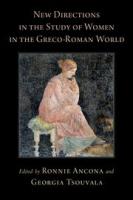
OUP (2021) h/b 300pp £64 (ISBN 9780190937638)
This academic volume of twelve specially commissioned essays, inspired by a panel at the 2015 Society for Classical Studies, is presented as a tribute to Sarah Pomeroy, and in particular to her ground-breaking book Goddesses, Whores, Wives and Slaves. Its keynote is variety, emphasising the wide-ranging specialisms of its contributors and the diversity of current work in the field of women’s history, employing new methodological questions and information as well as older tools, such as literary texts, for fresh purposes. It is aimed at scholars and students of women’s lives in Greco-Roman antiquity as well as those of women’s studies in other periods.
The first essay utilises Euripides’ Hippolytus as a springboard to suggest the way in which modern attitudes concerning the unreliability of female testimony have been shaped by fictional accounts of vengeful women falsely incriminating men who spurned their sexual advances. Following contributions deal with the reception of Penelope in 5th C Athens by means of the discovery in 1945 of an apparently Greek original marble statue of a seated woman in the ruins of the palace of Persepolis; the role of Phila, daughter of Alexander’s general, Antipater, as a prototype of the basilissa in the Hellenistic world; and a reappraisal of the motivation of Artemisia II in commissioning the Mausoleum and associated cultural competitions as part of a programme to rehabilitate the reputation of the corrupt and unpopular Mausolus, while bolstering her own position as sole ruler after his death.
The backstage influence of Roman women of age and rank like Augustus’ wife, Livia, and her circle of female friends is explored in a chapter of speculation about possible political motives lying behind Tacitus’ account of the death of Apronia, apparently thrown from a height by her husband in AD 24. This is followed by a retrospective survey of a century of papyrological scholarship, demonstrating its ability to shine a spotlight on individual women’s lives in Greco-Roman Egypt. Papyrological evidence is also utilised, as well as literary, archaeological and medical sources, to reveal attitudes towards the use of cosmetics by both sexes in the ancient world. Next comes an interesting and well-documented article on female athletes, examining inscriptional evidence to present a picture of women’s participation in gymnasia, palaestrae and professional competitions of the Late Hellenistic and Roman Greek world in wrestling, foot races, music and philosophical declamation.
Later chapters explore the treatment of under-age marriage by Roman jurists and its impact on property and inheritance laws and adultery in the imperial era; speculate on possible reasons behind Augustus’ marriage and adultery laws as attempts to curb the financial freedom of wealthy women; and signal the need to challenge not just the content but also the epistemology of women’s history. While women demonstrably feature less often than men in ancient historical writing, this may be a reflection of the lack of authoritative sources available to ancient historians like Livy and Polybius, in addition to the bias caused by their rhetorical training, which dealt in stock, time-honoured tropes.
The volume concludes with a paper indicating that Roman comedies, which contain many female characters of different ranks, are a good place to look for mid-republican Roman portrayals of, and attitudes towards, women’s experience of the world, demonstrating their familiarity with handling money, expressing political opinions and moving freely about the city.
Many of the essays in this collection are not just themselves presenting new directions in the study of women in the Greco-Roman world, but also indicating new directions for future research in this field. It only goes to show how much there is still to discover about the lives of women in antiquity.
Claire Gruzelier
